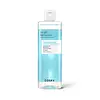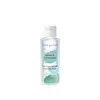What's inside
What's inside
 Key Ingredients
Key Ingredients

 Benefits
Benefits

 Ingredients Side-by-side
Ingredients Side-by-side

Water
Skin ConditioningPEG-6 Caprylic/Capric Glycerides
EmulsifyingPEG/PPG/Polybutylene Glycol-8/5/3 Glycerin
HumectantDecyl Glucoside
CleansingPoloxamer 184
EmulsifyingGlycerin
HumectantCamellia Sinensis Leaf Extract
AntimicrobialSalix Nigra Bark Extract
Skin ProtectingPEG-50 Hydrogenated Castor Oil
EmulsifyingZinc PCA
HumectantO-Cymen-5-Ol
AntimicrobialDisodium EDTA
Polyquaternium-10
Citric Acid
BufferingSodium Benzoate
MaskingCetrimonium Bromide
AntimicrobialWater, PEG-6 Caprylic/Capric Glycerides, PEG/PPG/Polybutylene Glycol-8/5/3 Glycerin, Decyl Glucoside, Poloxamer 184, Glycerin, Camellia Sinensis Leaf Extract, Salix Nigra Bark Extract, PEG-50 Hydrogenated Castor Oil, Zinc PCA, O-Cymen-5-Ol, Disodium EDTA, Polyquaternium-10, Citric Acid, Sodium Benzoate, Cetrimonium Bromide
 Reviews
Reviews

Ingredients Explained
These ingredients are found in both products.
Ingredients higher up in an ingredient list are typically present in a larger amount.
Citric Acid is an alpha hydroxy acid (AHA) naturally found in citrus fruits like oranges, lemons, and limes.
Like other AHAs, citric acid can exfoliate skin by breaking down the bonds that hold dead skin cells together. This helps reveal smoother and brighter skin underneath.
However, this exfoliating effect only happens at high concentrations (20%) which can be hard to find in cosmetic products.
Due to this, citric acid is usually included in small amounts as a pH adjuster. This helps keep products slightly more acidic and compatible with skin's natural pH.
In skincare formulas, citric acid can:
While it can provide some skin benefits, research shows lactic acid and glycolic acid are generally more effective and less irritating exfoliants.
Most citric acid used in skincare today is made by fermenting sugars (usually from molasses). This synthetic version is identical to the natural citrus form but easier to stabilize and use in formulations.
Read more about some other popular AHA's here:
Learn more about Citric AcidDisodium EDTA plays a role in making products more stable by aiding other preservatives.
It is a chelating agent, meaning it neutralizes metal ions that may be found in a product.
Disodium EDTA is a salt of edetic acid and is found to be safe in cosmetic ingredients.
Learn more about Disodium EDTAWater. It's the most common cosmetic ingredient of all. You'll usually see it at the top of ingredient lists, meaning that it makes up the largest part of the product.
So why is it so popular? Water most often acts as a solvent - this means that it helps dissolve other ingredients into the formulation.
You'll also recognize water as that liquid we all need to stay alive. If you see this, drink a glass of water. Stay hydrated!
Learn more about WaterZinc PCA (or "zinc salt") differs slightly from zinc itself. PCA stands for pyrrolidone carboxylic acid. However, Zinc PCA comes from zinc.
It can help reduce redness, regulate sebum, and promote the general healing process of the skin.
Zinc PCA tends to be especially useful for those with oily, acne-prone skin. It's certainly an ingredient worth trying out!
Learn more about Zinc PCA